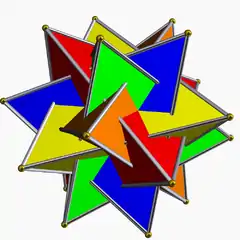Exceptional isomorphism
In mathematics, an exceptional isomorphism, also called an accidental isomorphism, is an isomorphism between members ai and bj of two families, usually infinite, of mathematical objects, which is incidental, in that it is not an instance of a general pattern of such isomorphisms.[note 1] These coincidences are at times considered a matter of trivia,[1] but in other respects they can give rise to consequential phenomena, such as exceptional objects.[1] In the following, coincidences are organized according to the structures where they occur.
Groups
Finite simple groups
The exceptional isomorphisms between the series of finite simple groups mostly involve projective special linear groups and alternating groups, and are:[1]
- the smallest non-abelian simple group (order 60) – icosahedral symmetry;
- the second-smallest non-abelian simple group (order 168) – PSL(2,7);
- between a projective special orthogonal group and a projective symplectic group.
Alternating groups and symmetric groups

There are coincidences between symmetric/alternating groups and small groups of Lie type/polyhedral groups:[2]
- Dihedral group of order 6,
- tetrahedral group,
- full tetrahedral group octahedral group,
- icosahedral group,
- ,
These can all be explained in a systematic way by using linear algebra (and the action of on affine -space) to define the isomorphism going from the right side to the left side. (The above isomorphisms for and are linked via the exceptional isomorphism .)
There are also some coincidences with symmetries of regular polyhedra: the alternating group A5 agrees with the icosahedral group (itself an exceptional object), and the double cover of the alternating group A5 is the binary icosahedral group.
Trivial group
The trivial group arises in numerous ways. The trivial group is often omitted from the beginning of a classical family. For instance:
- , the cyclic group of order 1;
- , the alternating group on 0, 1, or 2 letters;
- , the symmetric group on 0 or 1 letters;
- , linear groups of a 0-dimensional vector space;
- , linear groups of a 1-dimensional vector space
- and many others.
Spheres
The spheres S0, S1, and S3 admit group structures, which can be described in many ways:
- , the last being the group of units of the integers;
- circle group;
- unit quaternions.
Spin groups
In addition to , and above, there are isomorphisms for higher dimensional spin groups:
Also, Spin(8) has an exceptional order 3 triality automorphism.
Coxeter–Dynkin diagrams
There are some exceptional isomorphisms of Dynkin diagrams, yielding isomorphisms of the corresponding Coxeter groups and of polytopes realizing the symmetries, as well as isomorphisms of Lie algebras whose root systems are described by the same diagrams. These are:
| Diagram | Dynkin classification | Lie algebra | Polytope |
|---|---|---|---|
| A1 = B1 = C1 | - | ||
| A2 = I2(2) | - | 2-simplex is regular 3-gon (equilateral triangle) | |
| BC2 = I2(4) | 2-cube is 2-cross polytope is regular 4-gon (square) | ||
| A1 × A1 = D2 | - | ||
| A3 = D3 | 3-simplex is 3-demihypercube (regular tetrahedron) |
See also
- Exceptional object
- Mathematical coincidence, for numerical coincidences
Notes
- Because these series of objects are presented differently, they are not identical objects (do not have identical descriptions), but turn out to describe the same object, hence one refers to this as an isomorphism, not an equality (identity).
References
- Wilson, Robert A. (2009), "Chapter 1: Introduction", The finite simple groups, Graduate Texts in Mathematics 251, vol. 251, Berlin, New York: Springer-Verlag, doi:10.1007/978-1-84800-988-2, ISBN 978-1-84800-987-5, Zbl 1203.20012[www.maths.qmul.ac.uk/~raw/fsgs.html 2007 preprint]
{{citation}}: CS1 maint: postscript (link) - Wilson, Robert A. (2009), Chapter 3